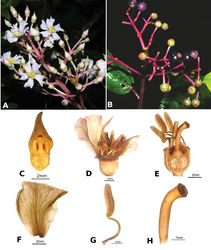Conostegia rhodopetala
| Notice: | This page is derived from the original publication listed below, whose author(s) should always be credited. Further contributors may edit and improve the content of this page and, consequently, need to be credited as well (see page history). Any assessment of factual correctness requires a careful review of the original article as well as of subsequent contributions.
If you are uncertain whether your planned contribution is correct or not, we suggest that you use the associated discussion page instead of editing the page directly. This page should be cited as follows (rationale):
Citation formats to copy and paste
BibTeX: @article{Kriebel2016PhytoKeys, RIS/ Endnote: TY - JOUR Wikipedia/ Citizendium: <ref name="Kriebel2016PhytoKeys">{{Citation See also the citation download page at the journal. |
Ordo: Myrtales
Familia: Melastomataceae
Genus: Conostegia
Name
Conostegia rhodopetala Donn. Smith – Wikispecies link – Pensoft Profile
- Conostegia rhodopetala Donn. Smith, Bot. Gaz. 42: 295. 1906. Type: Costa Rica. San José: La Palma de San José, 1500–1700 m, 22 May 1898, Tonduz 12347 (lectotype: NY!, designated here; isolectotypes: BR!, F!, US!). Other syntypes: COSTA RICA. San José: La Palma de San José, 1500–1700 m, A. Tonduz 9702 (BR!(2), NY!, US!), H. Pittier 10169 (BR!(2), M!, US!); Heredia: San Isidro, Rio de Las Lajas,1500 m, H. Pittier 14022 (F!, NY!, US!).
Description
Trees 3–12 m tall with tetragonal glabrous stems that sometimes have inconspicuous dendritic trichomes particularly noticeable when dry; the nodal line present but faint. Leaves of a pair equal to somewhat unequal in length. Petiole 1–7.1 cm. Leaf blades 7–23.1 × 3–9.8 cm, 3–5 plinerved, with the innermost pair of primary veins diverging from the mid vein 0.5–1 cm above the base in opposite or sub opposite fashion, elliptic to oblong or elliptic ovate, the base acute or obtuse, the apex acute to caudate, the margin entire, glabrous on both surfaces (except some specimens with tiny dendritic trichomes abaxially). Inflorescence a terminal panicle 11–25.7 cm long branched above the base but sometimes appearing branched at the base because of multiple inflorescences arising at opposing meristems at the terminal node, accessory branches present, rachis pink; bracts and bracteoles apparently lacking. Pedicel 2–15 mm. Flowers (5-)6(-7) merous, calyptrate. Floral buds 5–11 × 2.5–5 mm, obovoid pyriform, the base obtuse, the apex apiculate, slightly constricted in the middle, the hypanthium 3.5–4 × 4–4.25 mm, campanulate glabrous. Petals 5–7(-8.3) × 6–8 mm, pink or rarely white, obovate, spreading, the apex emarginate, glabrous. Stamens 12–15(-17), 4.5–6.5 mm long, slightly zygomorphic, the filaments 2.25–3.75 mm, white, anthers 2.5–3.25 × 0.75–1 mm, elliptic to oblong, sagittate at the base, somewhat laterally compressed, yellow, the pore around 0.1 mm wide, terminal to slightly ventrally inclined. Ovary (5-) 6 (-7) locular, inferior, the apex glabrous, forming a collar around the style. Style 4.5–5 mm, bent below the stigma, vertical distance between anther pore and stigma ca. -1 – -0.5 mm, horizontal distance ca. 0–1mm, stigma slightly expanded, 0.75–1 mm wide. Berry 6–7 × 6–7 mm, purple-black. Seeds 0.3–0.55 mm, ovoid to pyramidal, the testa smooth.
Distribution
(Fig. 102). Cloud forests in Costa Rica reaching western Panama, 700–1900 m in elevation. Conostegia rhodopetala can be distinguished by being almost entirely glabrous, having pink inflorescences and floral buds, apiculate floral buds and pink petals. It is similar to Conostegia superba, which as Almeda (2009)[1] recently mentioned has wider leaves and white petals. Schnell (1996)[2] noted a delay in of up to 5–6 months in fruit ripening and a much shorter fruiting than flowering season.
Specimens examined
COSTA RICA. Alajuela: San Ramón, Reserva Monteverde, Sendero El Camino, Haber and Zuchowski 12398 (INB, NY); San Carlos, La Tigra, entre la Fila divisoria de agua (Rincón de Cedral) y cerro Bekom, Herrera et al. 8999 (CR, MO, NY); vicinity of La Palma, Maxon 445 (NY); Zapote de San Carlos, Smith 381 (NY); Guadalupe de Zarcero, cantón de Alfaro Ruiz, Smith 702 (NY); P. N. Juan Castro Blanco. Cuenca alta del río La Vieja. Colectando a orillas del río y en la fila, Solano et al. 2667 (INB, NY). Cartago: Jiménez, Pejibaye, Turrialba, Refugio El Copal, Sendero Galbula, Kriebel et al. 5462 (INB, NY); Volcan Turrialba on road from La Trinidad to Lechería La Central, Schnell 1076 (NY). Heredia: Vara Blanca on road to Cariblanco, Schnell 1081 (MO, NY); Vara Blanca de Sarapiquí north slope of Central Cordillera, Skutch 3224 (NY). Puntarenas: Coto Brus, Sendero Las Tablas camino a Cotoncito, Kriebel and Solano 3176 (INB, NY). San José: Moravia, P.N. Braulio Carrillo, Cuenca del Sarapiquí, Camino al Bajo de la Hondura, Acosta and Ramírez 389 (INB, NY); Woods high above Río Cascajal 3 km N.E. of Cascajal, Lent 2177 (NY); Vicinity of El General, Skutch 2989 (MO, NY).
PANAMA. Chiriquí: Sendero Rio Hornito, Kriebel and Burke 5760 (PMA, NY).
Taxon Treatment
- Kriebel, R; 2016: A Monograph of Conostegia (Melastomataceae, Miconieae) PhytoKeys, (67): 1-326. doi
Images
|
Other References
- ↑ Almeda F (2009) Melastomataceae. In: Davidse G Sousa-Sánchez M Knapp S Chiang F (Eds) Flora Mesoamericana (vol. 4). Universidad Nacional Autónoma de México, 164–338.
- ↑ Schnell C (1996) The Genus Conostegia (Melastomataceae). PhD thesis, Harvard University.

